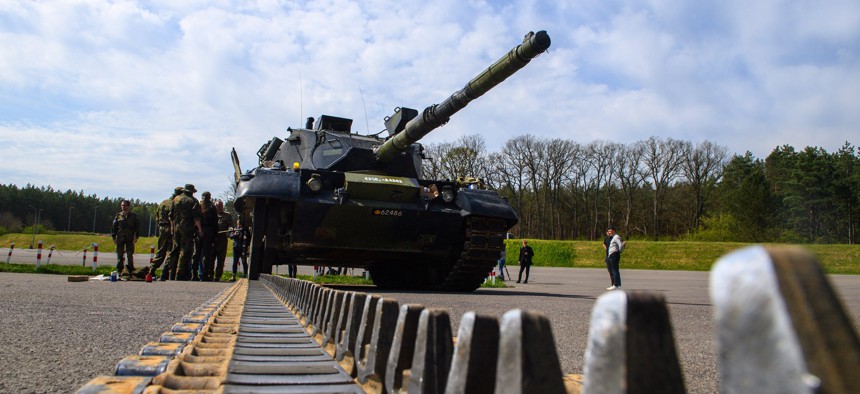
Ukrainian soldiers work on a Leopard 1 A5 main battle tank at the Bundeswehr site in Klietz in northern Saxony-Anhalt on May 5, 2023. Their instructors are German and Danish soldiers and industry technicians. Photo by Klaus-Dietmar Gabbert/picture alliance via Getty Images
Defense Business Brief: Old meets new; Rheinmetall’s Ukrainian deal; Hypersonic industrial base; and more
Last week, L3Harris Technologies and BigBear.ai announced they would team up to develop autonomous surface-vessel technology for the military. The former will integrate its autonomous vessel control system with the latter’s forecasting computer vision “to better identify and classify vessels, enhance situational awareness and support manned-unmanned teaming missions.”
It’s just the latest tie-up between an established defense firm and a specialized tech startup, most aimed at serving a Pentagon craving new ways to automate decades-old processes. Military officials believe technology, particularly artificial intelligence and machine learning, can help commanders make decisions faster, something they say is necessary if the U.S. ever goes to war with a peer.
Some other notable teaming arrangements include:
- Northrop Grumman has teamed with Shield AI to compete for the Army’s Future Tactical Unmanned Aircraft System, a new drone that will replace the RQ-7B Shadow. Shield AI makes the V-BAT drone.
- Boeing has a teaming agreement with Shield AI “to explore strategic collaboration in the areas of autonomous capabilities and artificial intelligence on current and future defense programs.”
- American Rheinmetall is installing Anduril’s software inside its Lynx armored vehicle that’s competing to replace the Army’s Bradley fighting vehicle.
- Raytheon Technologies is teamed with C3.ai “to deliver next-generation AI and machine learning capabilities” for the Army’s Tactical Intelligence Targeting Access Node, or TITAN, program.
- Boeing and AI-specialist SparkCognition have a joint venture called Skygrid that is developing a next-generation air traffic control system for drones and other aircraft.
- Lockheed Martin Ventures has made investments in several artificial intelligence companies including Calypso AI, Darwin AI, and Latent AI.
- BigBear.ai is also backed by AEI HorizonX, Boeing’s venture arm.
Welcome
You’ve reached the Defense Business Brief by Marcus Weisgerber. Send along your tips, and feedback to mweisgerber@defenseone.com or @MarcusReports. Check out the Defense Business Brief archive here, and tell your friends to subscribe!
Germany has pledged nearly $3 billion in weapons to Ukraine, Berlin’s largest single contribution since Russia invaded in February 2022. The package includes Leopard tanks, Marder armored personnel carriers, reconnaissance drones, and air defenses.
Also: Germany’s Rheinmetall has signed an agreement with Ukroboronprom, Ukraine’s state-owned defense conglomerate. “Cooperation between the two organizations is intended to strengthen Ukraine’s defense industry and ultimately its national security through the step-by-step creation of joint defense technology capabilities that will be domiciled in Ukraine,” Rheinmetall said in a statement. “Under this agreement, Ukraine will benefit from a comprehensive transfer of technology, the creation of additional defense technology capacities in Ukraine, additional local value added, and the short-term delivery of military equipment from Germany.” Rheinmetall and Ukroboronprom also plan to establish by July a joint venture “to serve as a bridge between Rheinmetall and Ukraine’s existing state-owned defence sector.”
The United Kingdom has sent long-range Storm Shadow cruise missiles to Ukraine, which Moscow says have already been used to strike industrial sites in Russian-held territory.
The Pentagon’s latest science-and-technology strategy calls for greater communication between the military, lawmakers, and even allies. Areas of emphasis in the strategy:
- Biotechnology, quantum science, future-generation wireless, and advanced materials;
- Commercial tech, such as artificial intelligence and autonomy, integrated networked systems-of-systems, microelectronics, renewable energy generation and storage, advanced computing and software; and human-machine interfaces; and
- Directed energy, hypersonics, and integrated sensing and cyber.
Read the entire report here.
Speaking of hypersonics, the National Defense Industrial Association’s Emerging Technology Institute has a new report about the hypersonic weapons industrial base found “significant steps must be taken to strengthen hypersonics supply chains. To rectify critical hypersonics supply chains vulnerabilities, a holistic and coordinated approach among government, industry, and academia is essential.”
The report also found that despite being a priority for the Pentagon, “DOD has often wavered in its commitment to fielding hypersonic systems at scale.…The most important step the DoD can take to secure hypersonics supply chains for the future is to provide a consistent demand signal to industry.”
Stratolaunch completed a key test that brings it a step closer to launching a hypersonic vehicle. The company’s six-engine Roc aircraft successfully released a Talon “separation test vehicle.” The test flight “performed risk reduction by demonstrating the Talon-A launch system can cleanly and safely separate hypersonic vehicles from Roc's center-wing pylon,” the company said. “The test also confirmed telemetry between the vehicles and Vandenberg Space Force Base's communication assets, assuring that back-up telemetry data collection will occur during future hypersonic flight tests.” Stratolaunch plans to conduct a hypersonic flight of its Talon vehicle in “late summer.”
Telecom startup Aalyria and defense startup Anduril have signed a teaming agreement “to integrate two key technologies that will advance the all-domain command and control of national security capabilities.” The companies will integrate Aalyria’s networking orchestration platform, called Spacetime, with Anduril’s Lattice Natsec software.
NEXT STORY: Want a DOD Contract? There'll Be an App for That




